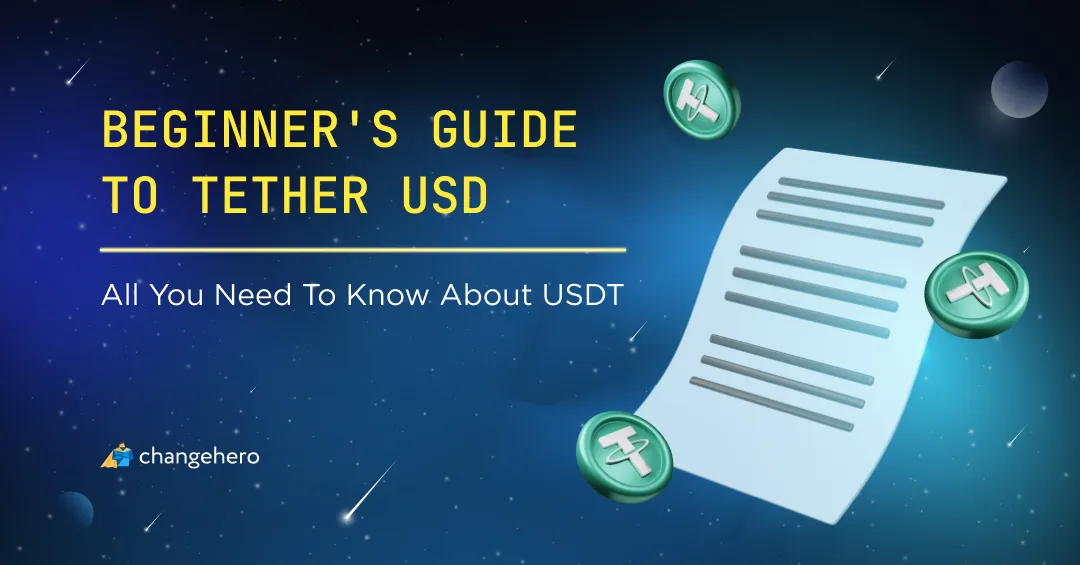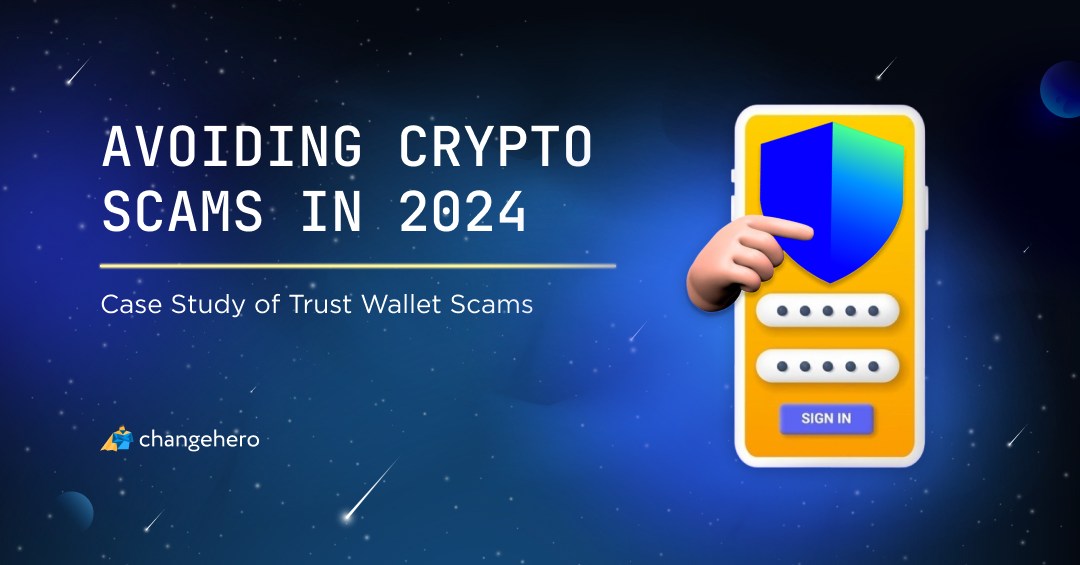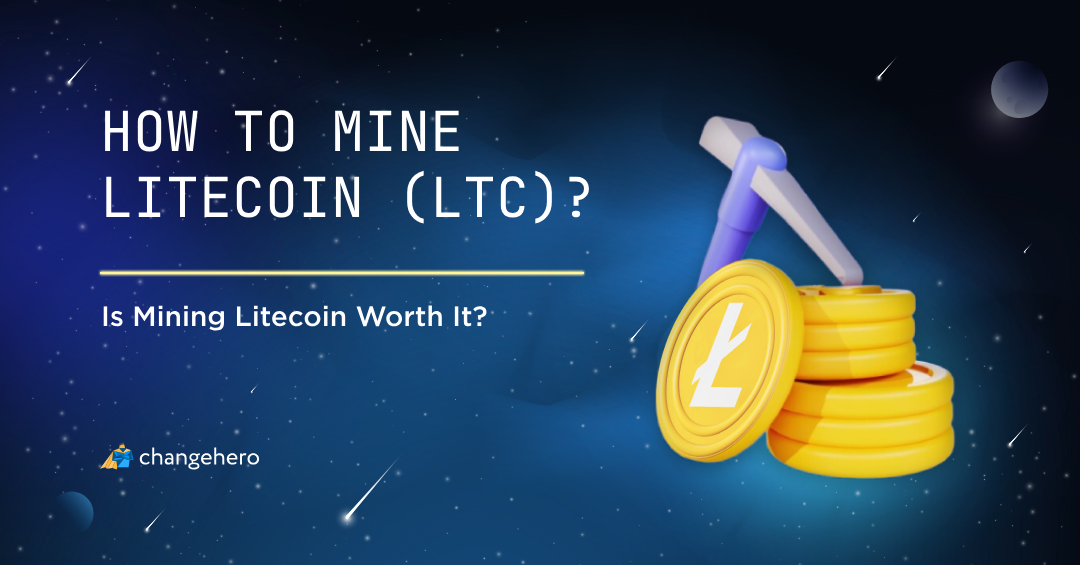At least on the basic level, any crypto holder knows what Tether USD is. It is a crypto asset the value of which is more or less equal to the US dollar. However, if you feel that the surface-level knowledge is not enough, we are eager to satisfy the need to learn more. In this guide, we give an extensive overview of the principles behind Tether USD (USDT) and the background of this stablecoin.
Key Takeaways
- Tether USD (USDT) is a stablecoin, or a crypto token with value linked to another asset — the U.S. dollar, on a 1:1 ratio.
- The stability of the value of USDT coins is ensured by the reserves in custody of its issuer, Tether Ltd. Since USDT is redeemable 1:1 to USD, the token retains this value in any transaction;
- Even though USDT is a somewhat controversial asset, it is the third most popular cryptocurrency and the most traded crypto asset across the whole market.
What is Tether?
When cryptocurrencies first started being traded, it quickly became apparent that their value was volatile or unstable. This was by design but in practice, the lack of stability made payments with digital currencies harder. When cryptocurrency tokens became a thing, the type of tokens with value directly linked to a fiat currency — stablecoins — emerged.

Tether (USDT) is one of such stablecoins, meaning its value is pegged to a fiat currency, in this case, the US dollar. It was created with the goal of providing stability and minimizing the volatility often associated with other cryptocurrencies.
To provide stability and a 1:1 exchange rate to USD, the company that created Tether stablecoins manages the supply of tokens in circulation and the reserves backing this circulating supply. The issuer of Tether tokens is Tether Limited, and they operate the cycle of minting and redemptions, as well as keep the reserve.
With Tether tokens, transactions between different cryptocurrencies and exchanges have become more approachable. End users won’t have to rely on traditional banking systems directly to transfer and trade USDT. Due to the history of transactions being recorded on the blockchain along with the smart contract, the on-chain aspect of Tether is fully transparent and verifiable.
How do Tether tokens work?
Today, Tether tokens exist on many blockchain platforms with smart contract functionality. While for every case the code of the smart contract would be different, in general, every Tether token contract specifies the following.
- Token standard: typically, these stablecoins are standard fungible tokens on each given blockchain;
- Transfer and ownership rights. In the case of centralized stablecoins, these rights can be modified by the contract owner, and individual users can get restricted or even blacklisted;
- Issuance and redemption of tokens. These are performed with the mint and burn functions on deposit and redemption respectively.
This covers the on-chain part of these stablecoins. However, there is a lot happening off-chain, too.

The circulating supply of Tethers is backed by a reserve in the custody of Tether Ltd. The bulk of it is comprised of cash equivalents like U.S. treasury bills, reverse repurchase agreements and money market funds.
By making sure that the supply of stablecoin tokens in circulation is equal to or below the amount of assets held in reserve, Tether Ltd. assures that each USDT or XAUT is redeemable on a 1:1 basis. This assumption is what ensures that all market participants see the value of Tether as stable and equal to $1.
Brief History of Tether and Tether Ltd.
Before we look into the history of this stablecoin, we have to understand why the U.S. dollar is de facto the fiat currency underpinning it. After all, the prices of cryptocurrencies, market capitalization, and total value locked are most commonly denominated in USD.
As a leading global reserve currency, USD is widely accepted, used in international trade and finance, and perceived as a benchmark of economic stability. The US dollar is highly liquid and stable in comparison to other local currencies. And not for the least part, the US has a well-developed financial infrastructure and solid motivation to build a legal framework for the crypto market.
Tether Ltd. is the company responsible for issuing and managing the stablecoin Tether (USDT). It was founded in 2014 as Realcoin and is incorporated in the British Virgin Islands. The company aims to provide a stable and secure digital currency that is pegged to the value of a fiat currency, typically the US dollar.
Tether Ltd. was created by a group of entrepreneurs, including Brock Pierce, Reeve Collins, and Craig Sellars. Tether was launched with the goal of providing a stablecoin that would be pegged to the value of a traditional fiat currency, specifically the US dollar.
Initially, Tether claimed that each USDT token was backed by one US dollar held in reserve. However, this claim has been the subject of controversy and scrutiny over the years. Despite these controversies, Tether has gained significant popularity and has become one of the most widely used stablecoins in the cryptocurrency market.
In recent years, Tether has expanded beyond the US dollar and has introduced stablecoins pegged to other fiat currencies, such as the Euro and the Chinese yuan. The company has also faced legal and regulatory challenges, including investigations by the New York Attorney General’s office.
What is Tether USD (USDT)?
Tether issues several stablecoins pegged to fiat currencies and gold but their flagship product is, without doubt, Tether USD (USDT). Not only it is by far the largest stablecoin of Tether, but at the moment, it is the largest stablecoin and the most traded token on the crypto market.
As of 2023, the networks that have the largest supply and circulation of USDT are Tron and Ethereum. Across both, on average, an equivalent of $13 billion USD gets transferred daily in 2.16 million transactions. The current circulating supply is estimated to be around $83 billion USD.
What is USDT payment useful for?
Due to being a dollar-pegged crypto token, USDT finds plenty of use cases. The blockchain combined with its dollar value creates a digital currency that can be used for trading, value transfers, including remittances, online purchases, and decentralized finance (DeFi).
USDT is widely supported on cryptocurrency exchanges and can be used for trading against other cryptocurrencies like Bitcoin or Ethereum. Many traders use USDT as a stablecoin to hedge against market volatility or to move funds quickly between different cryptocurrencies.
USDT can also be used for peer-to-peer transactions. If both parties have a compatible wallet that supports USDT, they can send and receive USDT tokens directly. This provides a way to transfer value digitally without relying on traditional banking systems.
Some online merchants and service providers accept USDT as a form of payment. These can include various industries such as gaming, e-commerce, and digital services. The Cryptwerk repository lists 1,500 points of purchase and 78 crypto payment gateways that accept USDT.
As we mentioned, USDT can be used for cross-border payments and remittances to send money internationally quickly and at a lower cost compared to traditional banking methods. This can be particularly useful in regions where access to banking services is limited.
Last but not least, USDT is often integrated into DeFi applications or blockchain-based financial protocols. These applications offer various financial services such as lending, borrowing, and yield farming.
Tether USD and similar projects
Tether (USDT) vs. USD Coin

Not long ago, our team made a comprehensive guide with a comparison between the two major stablecoins. If you are interested in learning more about the distinction in-depth, we recommend checking it out. If you only need the gist, keep reading.
Obviously, the first difference is the brand, and what company is behind it. Tether is issued by a company of the same name and USD Coin is a product by a fintech company Circle. Tether is connected with a Bitfinex crypto exchange, and USD Coin was launched and initially supported by the now defunct Centre consortium, made up of Circle and a crypto exchange Coinbase.
Both issuers claim to be regulated and sufficiently licensed to offer their stablecoins. However, while Circle focuses on the domestic market and engages in creating the legal framework for crypto in the US, Tether is more of an off-shore entity and officially states they do not serve US citizens.
Despite stronger law compliance and more strict bookkeeping of USD Coin, Tether USD is a more widely adopted choice.
Tether (USDT) vs. Dai
As we mentioned before, Tether’s stablecoins are centralized, so it implies that there are decentralized stablecoins as well. The most popular one is Dai (DAI) by MakerDAO, which is not a company but a decentralized autonomous organization.
Unlike USDT backed by cash equivalents and other real-world assets, Dai stablecoins are backed by collateral in cryptocurrencies. To compensate for the volatility of the collateral, the smart contracts of the Maker protocol require over-collateralization. In other words, the amount of collateral backing DAI has to be multiple times higher than the amount of DAI minted. Because the value of the collateral can fluctuate, DAI is soft-pegged to USD, and if it goes below a certain threshold, it will be liquidated by a smart contract.
What are the merits of Dai if it gets you less for your buck than a straightforward conversion of Tether? DAI is a decentralized stablecoin, so its reserves in the smart contract are auditable at any time. There are no mechanisms to freeze a transaction or blacklist an address from transacting in DAI. Finally, any member of the MakerDAO gets to have a say in the workings and future of the protocol.
Is Tether controversial?
It is common knowledge among most crypto users that Tether and USDT are somewhat controversial. At various points, concerns have been raised about its transparency, backing, and even market manipulation.
The transparency and communication on Tether’s reserves leaves a lot to be desired: for years, they refused to provide an official audit, even though they have an independent auditor give attestations. The difference is that in an audit, the full state of the company’s finances is reviewed, while an attestation can only confirm or deny the accuracy of the provided information.
Together with Bitfinex and a few more crypto companies, since 2019 Tether has been a part of a class action lawsuit alleging the companies manipulated the market. In 2021, iFinex — the parent company of both Bitfinex and Tether — settled another investigation with the New York State Attorney General, also directed at the legitimacy of the USDT issuer’s reserves. What is more, Tether has faced regulatory scrutiny from various authorities, including the U.S. Commodity Futures Trading Commission (CFTC) and the Department of Justice (DOJ).
Nevertheless, the reliance on the USDT and the trust in the dollar peg currently seem to be stronger than concerns about its legitimacy.
Tether’s Partners and Future
Stablecoins, especially centralized ones, are in a curious spot regarding their future plans. It can be argued that since USDT already achieves what it set out to do, there is no need to update the contracts. So, the best-case scenario for the future of Tether is to commit to transparency and if need be, adapt to the changes in the crypto market.
Crypto critics are adamant that Tether’s conduct is unsustainable, and in the case of a bank run or any other unexpected event, it will go down. When Terra USD (UST), which had a fraction of the Tether’s share on the market, collapsed, the crypto market crashed. And if the same were to happen to USDT, the consequences are going to be much worse, they warn.
Tether seems to be hard at work to not let this happen. Currently, aside from handling the legal cases, they are working on a few initiatives to bolster trust in cryptocurrencies. With the city of Lugano, Tether formed a Plan B alliance to transform this Swiss city into a Bitcoin and blockchain tech hub.
As for the changes to adapt, in August Tether surprised everyone by announcing the discontinuation of USDT on three blockchain platforms. They have ceased minting USDT on Kusama, Bitcoin Cash SLP, and the layer-two for Bitcoin that USDT was originally launched on, Omni. The move was probably made with the lack of demand in mind and is a change as necessary and healthy as the extension of supported blockchains. Right now, Tether USD is available on 11 blockchain platforms: Tron being the largest, followed by Ethereum, Solana, and Avalanche.
Which crypto wallet to use for USDT?
It is not a hard task to find a crypto wallet that supports one of the most ubiquitous assets on the market. However, there are so many options that you may feel a little lost. Let us share a couple of ideas:
- First of all, pay attention to the network you want USDT to be on. For example, TRC-20 and ERC-20 USDT will have different address formats, and you cannot send one asset to another network without a bridge or swap;
- Some of the most versatile and convenient crypto wallets for Ethereum tokens are Metamask and MEW. Popular multi-currency wallets like Guarda and Trust Wallet will let you store and manage USDT on Ethereum and TRON. Keep in mind that these wallets are for hot storage and require an Internet connection to synchronize, potentially opening your funds up to a hack or phishing attack.
- To safely store your USDT offline, we recommend hardware wallets like Trezor and Ledger. These devices start at around $80 a piece but are considered to be the most reliable crypto storage option.
Where to buy Tether USD (USDT)?
Tether (USDT) is available on most centralized exchanges, so it is highly liquid and easy to get. For example, to buy or sell USDT, you can look no further than on ChangeHero’s Buy and Sell crypto page. Our partners will make sure you get the best rates and a smooth experience.
Want to trade crypto for USDT or the other way around? Do it easily on ChangeHero! We will find the best rate across ten liquidity providers in real time, and you can start right away with no need to sign up.
- Choose the currencies on the home page, amounts, and the type of exchange. Provide your USDT wallet address in the next step and check the details;
- Double-check the provided information, read and accept the Terms of Use and Privacy Policy;
- Send the cryptocurrency for the swap in a single transaction. In a Fixed Rate transaction, you have 15 minutes before it expires;
- Sit back and relax. Now we are doing all the work: checking the incoming transaction and making the exchange as soon as it arrives;
- As soon as the exchange has been processed, your USDT is on its way to your wallet. And so, the transaction is finished!
The flow is as easy as it gets but if you struggle with something, don’t worry. Our support team is available 24/7 to help you in the chat or through the email: [email protected].
Conclusion
Tether USD is an elegant solution to the volatility problem of the crypto market, and because of its straightforwardness, it massively grew in popularity. Some of its aspects remain questionable, though: is it reliable or legitimate enough? Is the idea of a fiat-pegged token beneficial for the crypto space in the first place?
Browse the ChangeHero blog to learn more about the latest crypto news, projects, and platforms. And for quick bite-sized updates, follow us on social media: Twitter, Facebook, Reddit, and Telegram.
Frequently Asked Questions
What is USDT in payment?
USDT stands for Tether USD, a crypto token that is worth $1 at any time. It can act as a digital dollar replacement for transfers outside of the traditional finance systems.
Is USDT the same as USD?
Even though USDT is dollar-pegged, it is a crypto token, meaning it is a digital asset with a value roughly equal to $1. USDT is not necessarily integrated into the financial system in the same way as USD but it can be used when trading cryptocurrencies, making transfers on blockchain, or availing of DeFi services.
Is paying with USDT safe?
If the parties you’re making the transfer to accept USDT payments, it’s safe to say they recognize it as being worth $1. USDT payments have a few qualities that make them even safer than regular payments: they are irreversible and fully transparent. Otherwise, attention should be paid to the network of the token and the validity of provided addresses and other details.
How do you convert USDT to cash?
Tether USD can be converted into fiat currencies on crypto exchanges and off-ramp providers. You can sell USDT for EUR and USD on ChangeHero.








